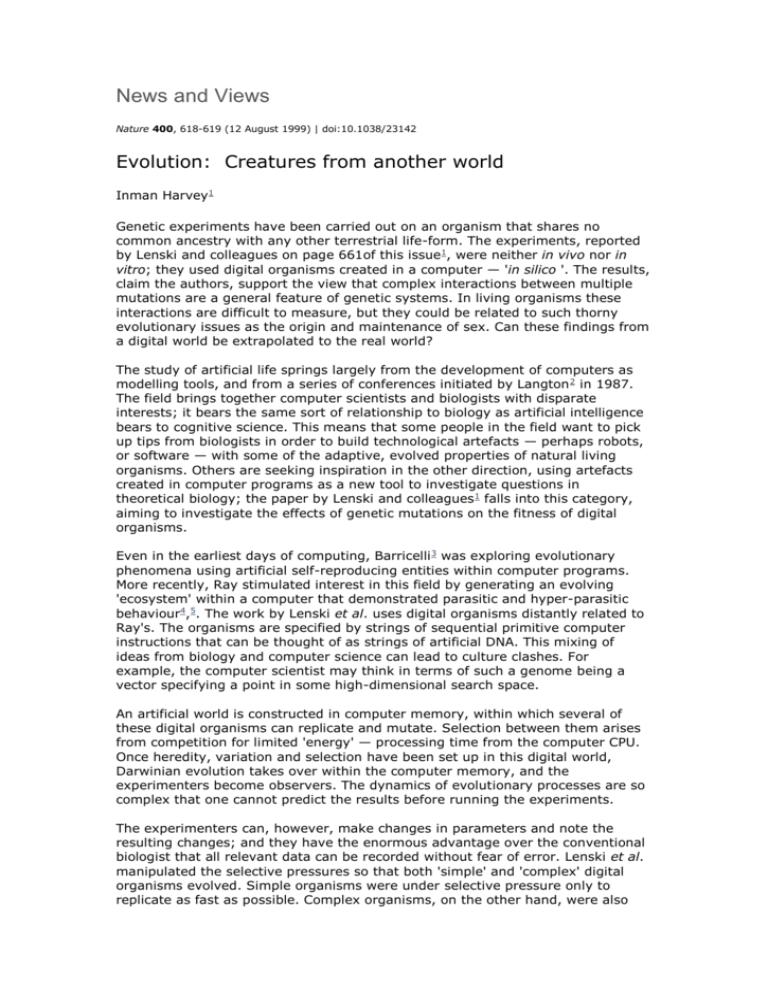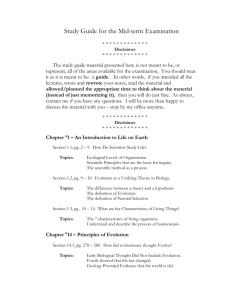Word - University of Sussex
advertisement

News and Views Nature 400, 618-619 (12 August 1999) | doi:10.1038/23142 Evolution: Creatures from another world Inman Harvey1 Genetic experiments have been carried out on an organism that shares no common ancestry with any other terrestrial life-form. The experiments, reported by Lenski and colleagues on page 661of this issue1, were neither in vivo nor in vitro; they used digital organisms created in a computer — 'in silico '. The results, claim the authors, support the view that complex interactions between multiple mutations are a general feature of genetic systems. In living organisms these interactions are difficult to measure, but they could be related to such thorny evolutionary issues as the origin and maintenance of sex. Can these findings from a digital world be extrapolated to the real world? The study of artificial life springs largely from the development of computers as modelling tools, and from a series of conferences initiated by Langton 2 in 1987. The field brings together computer scientists and biologists with disparate interests; it bears the same sort of relationship to biology as artificial intelligence bears to cognitive science. This means that some people in the field want to pick up tips from biologists in order to build technological artefacts — perhaps robots, or software — with some of the adaptive, evolved properties of natural living organisms. Others are seeking inspiration in the other direction, using artefacts created in computer programs as a new tool to investigate questions in theoretical biology; the paper by Lenski and colleagues 1 falls into this category, aiming to investigate the effects of genetic mutations on the fitness of digital organisms. Even in the earliest days of computing, Barricelli 3 was exploring evolutionary phenomena using artificial self-reproducing entities within computer programs. More recently, Ray stimulated interest in this field by generating an evolving 'ecosystem' within a computer that demonstrated parasitic and hyper-parasitic behaviour4,5. The work by Lenski et al. uses digital organisms distantly related to Ray's. The organisms are specified by strings of sequential primitive computer instructions that can be thought of as strings of artificial DNA. This mixing of ideas from biology and computer science can lead to culture clashes. For example, the computer scientist may think in terms of such a genome being a vector specifying a point in some high-dimensional search space. An artificial world is constructed in computer memory, within which several of these digital organisms can replicate and mutate. Selection between them arises from competition for limited 'energy' — processing time from the computer CPU. Once heredity, variation and selection have been set up in this digital world, Darwinian evolution takes over within the computer memory, and the experimenters become observers. The dynamics of evolutionary processes are so complex that one cannot predict the results before running the experiments. The experimenters can, however, make changes in parameters and note the resulting changes; and they have the enormous advantage over the conventional biologist that all relevant data can be recorded without fear of error. Lenski et al. manipulated the selective pressures so that both 'simple' and 'complex' digital organisms evolved. Simple organisms were under selective pressure only to replicate as fast as possible. Complex organisms, on the other hand, were also 'rewarded' (with extra CPU time) for performing certain mathematical functions. Lenski and colleagues then measured the fitnesses (replicative rates) of many mutant copies of these evolved organisms. Mutations are usually harmful, and each successive mutation tends to reduce fitness further. In the simplest, multiplicative situation, a mutation has the same relative effect on the fitness of an unmutated organism as on one that is already mutated. There can, however, be different kinds of interaction between successive mutations: synergistic epistasis, where the cumulative effects of multiple mutations are worse than is implied by their individual effects, and antagonistic epistasis, where the effects are less damaging. In these experiments the complex digital organisms showed antagonistic epistasis; they were relatively robust to the effect of multiple mutations. When the overall results were studied, simple organisms appeared to display no significant epistasis. The ease of data collection in such computer experiments, however, allowed exhaustive analysis. This showed that there were indeed some epistatic interactions in these simple organisms, but that the synergistic and antagonistic effects largely balanced out. Do these results from an artificial world have any relevance to organisms in the natural world? Workers in this field argue that these techniques allow one to make generalizations about evolving systems, stepping out of the restrictions of a terrestrial, DNA-based world, where all are derived from a common ancestor — but care is needed. To be able to make such generalizations, the conditions under which these digital organisms develop must be set up without any bias favouring one result or another, which requires great care. The approach used by Lenski and colleagues1 raises more questions than do their specific findings. When theoretical biologists reduce a complex ecosystem to a simple analytical formula, it is clear that that they are assuming, for the sake of their theory, that only a small number of factors are relevant. The Artificial Life approach comes into its own when analysis is difficult but computer simulations feasible; however, the assumptions used may be less obvious. The advantages of experiments using digital organisms suggest that they will find further uses in those vast areas of evolutionary theory where analysis is intractable. However, considerable debate can be expected before a consensus is reached on just what is necessary for results from a synthesized world to be seen as relevant to the natural world. References 1. Lenski, R. E. , Ofria, C. , Collier, T. C. & Adami, C. Nature 400, 661–664 (1999). 2. Langton, C. (ed.) Artificial Life (Addison-Wesley, Redwood City, California, 1989). 3. Barricelli, N. A. Acta Biotheoretica XVI, 69-98 (1962). 4. Ray, T. S. in Artificial Life II (eds Langton, C. G., Taylor, C., Farmer, J. D. & Rasmussen, S.) 371-408 (Addison-Wesley, Redwood City, California, 1991). 5. 1. Maynard Smith, J. Nature 335, 772–773 (1992). Inman Harvey is at the Centre for the Study of Evolution, and the Centre for Computational Neuroscience and Robotics, University of Sussex, Brighton BN1 9QH, UK. e-mail: Email: inmanh@cogs.susx.ac.uk







